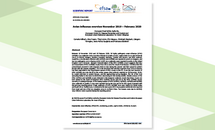Avian influenza overview August – December 2020
Between 15 August and 7 December 2020, 561 highly pathogenic avian influenza (HPAI) virus detections were reported in 15 EU/EEA countries and UK in wild birds, poultry and captive birds, with Germany (n=370), Denmark (n=65), the Netherlands (n=57) being the most affected countries.
Executive Summary
Between 15 August and 7 December 2020, 561 highly pathogenic avian influenza (HPAI) virus detections were reported in 15 EU/EEA countries and UK in wild birds, poultry and captive birds, with Germany (n=370), Denmark (n=65), the Netherlands (n=57) being the most affected countries.
The majority of the detections have been reported in wild birds (n=510), primarily in barnacle goose, greylag goose, and Eurasian wigeon. Raptors have also been detected infected, particularly common buzzard. The majority of the birds had been found dead or moribund, however, there are also reports of HPAI virus infection in apparently healthy ducks or geese. A total of 43 HPAI outbreaks were notified in poultry; with signs of avian influenza infection being observed in at least 33 outbreaks; the most likely source of infection was indirect contact with wild birds.
Three HPAI virus subtypes, A(H5N8) (n=518), A(H5N5) (n=17) and A(H5N1) (n=6), and four different genotypes were identified, suggesting the occurrence of multiple virus introductions into Europe. The reassortant A(H5N1) virus identified in EU/EEA countries has acquired gene segments from low pathogenic viruses and is not related to A(H5N1) viruses of e.g. clade 2.3.2.1c causing human infections outside of Europe.
As the autumn migration of wild waterbirds to their wintering areas in Europe continues, and given the expected local movements of these birds, there is still a high risk of introduction and further spread of HPAI A(H5) viruses within Europe.
The risk of virus spread from wild birds to poultry is high and Member States should enforce in ’high risk areas’ of their territories the measures provided for in Commission Implementing Decision (EU) 2018/1136. Detection of outbreaks in breeder farms in Denmark, the Netherlands and United Kingdom, highlight also the risk of introduction via contaminated materials (bedding/straw) and equipment.
Maintaining high and sustainable surveillance and biosecurityparticularly in high-risk areas is of utmost importance. Two human cases due to zoonotic A(H5N1) and A(H9N2) avian influenza virus infection were reported during the reporting period. The risk for the general population as well as travel-related imported human cases are assessed as very low.
Download







